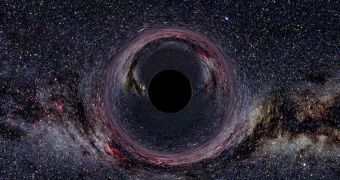Over the years, the concept of “black hole” has made its way from Science to fiction and then to everyday life. Now, the words are used in common expressions, but the public actually knows very little about how these objects appear, how they develop, and what role they ultimately play in their general vicinities. The great physicist Albert Einstein predicted in his Theory of General Relativity that the structures would be invisible to the human eye. Yet, astrophysicists are somehow able to detect them. The question is how.
One of the most important things about black holes is the fact that they have the highest mass per unit volume in the entire Universe. They therefore exert a tremendous gravitational pull, which not only affects matter around them, but can also bend time and space, warping them beyond recognition. At a certain distance away from the black hole, in a space generally referred to as the even horizon, the pull is so great, that it doesn't even allow photons, the basic particles making up light, to escape. Therefore, it appears completely black to the human eye.
Experts say that, most of the time, only 'circumstantial evidence' on the existence of such a celestial object can be found. For example, in the case of our own galaxy, there are a large number of stars in the core regions, which orbit around an undetectable, invisible mass, at very high speeds. Such behavior cannot be explained through any other known phenomenon, apart from the existence of a black hole at the very center of the Milky Way.
Another method of spotting the elusive structures is to hunt for accretion disks. These are formed when matter around a black hole gets sucked in, but is unable to pass through the even horizon, on account of the action of angular momentum. Therefore, the particles begin to spin frantically around the black hole, which makes the entire disk heat up. As such, it begins to glow in all wavelengths of the electromagnetic spectrum and becomes visible to advanced telescopes. The black hole itself remains veiled, but astronomers now know that only such an object could create this type of accretion disc.
Astrophysicists also find black holes by observing how a star is literally dismembered and torn apart. If it gets too close, the star starts shedding mass, which is naturally accumulated by the black hole. The phenomenon is spectacular, and it produces characteristic X-ray radiation, which can also be identified via modern telescopes. In essence, the researchers dealing with finding these structures take a Sherlock Holmes-esque approach – study the data, collect information, and then draw logical conclusions based on previous knowledge, Space Fellowship reports.

 14 DAY TRIAL //
14 DAY TRIAL //